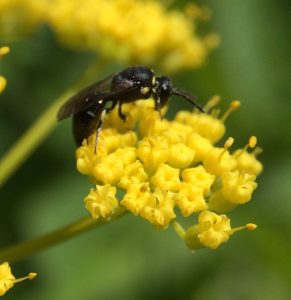
Native pollinators are a very important and diverse group of animals with fascinating ecologies; unfortunately, few people are aware of them and their importance because of the media’s focus on honeybees.
Despite the many articles written about colony collapse, honeybees are not going extinct. Their issues are not ones of conservation, but instead are ones of domestic animal management.
The animals we do need to be worried about are our native pollinators. This post will give a brief run-down of why we should care, who they are and what they need. There are many lists online for pollinator plants. Our lists below are tried and true for the Chicago Region, borne out of years of our own planting and observations. You can get many of these plants at our plant sales (Shrub and tree sale coming this fall!), or you can go to our page that lists plant resources.
Recommendations (books and sites) for further study will be given at the end of this post.
-
What is a native pollinator?
Native pollinators are simply animals that have evolved in our area and were here prior to European colonization and do the bulk of the pollination work. Some of them have very close ties to the plants they evolved with. Examples of native pollinators are Mining bees, small Carpenter bees, Bumblebees, Leafcutter bees, Orchard bees, butterflies, moths, beetles, and flies, hummingbirds and so on.
2. Why should I care about native pollinators?
Most people need an economic reason (or one that privileges human needs/desires), and one is that native pollinators are worth billions of dollars of FREE pollination services. If given resources and appropriate habitat, they can offer farmers, gardeners, and others billions of dollars of pollination services.
Many of these pollinators have specialist relationships with plants, and without pollinators many plants would simply disappear or need to be hand-pollinated. Tomato flowers are best pollinated by Bumblebees because of their ability to sonicate, or buzz-pollinate, the flowers. Other pollinators are best for apples and blueberries.
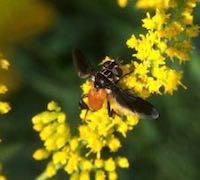
Pollinators like Hover Flies have an added dimension of importance to us. The adults are plant pollinators while their larvae do pest control. Several beetles help with pollination, and their larvae are important in the soil food web. Even flies are pollinators, and they are a pretty amazingly diverse group, worthy of more attention and respect as well.
3. What’s the big deal?
While a lot of information and concern has come out for the honeybee, very little attention (until recently) has been paid to our native pollinators. Scientists who study them are concerned about an apparent decline in their abundance. The main reasons are habitat loss, invasive species, and pesticides. Honeybees also introduce diseases and parasites into the native bee populations and put incredible competitive pressure on our native bees. A single hive of honeybees contains 20,000-50,000 honeybees. Those numbers far outstrip the relatively small numbers of native bees, most of which are solitary nesters, except for bumblebees.
4. What can I plant for them?
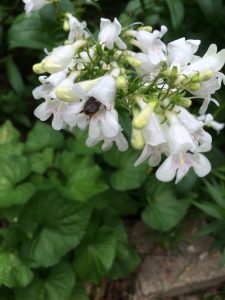
Native pollinators need plants from early spring to late fall. Each species has a different life cycle and timeline. Some will only appear as adults in early spring, so they have one generation. Other species might have two or more generations during the spring-fall period. Spring and fall are times of sparse resources for pollinators, particularly bees. Not only do they need nectar, but pollen is extremely critical too since it is a source of protein and other nutrients for these animals. Some bees are what is known as oligolectic which means they specialize on a particular group of plants for their pollen.
Here are some plants we have found to be popular with pollinators through the seasons:
Spring: Pussy Willow, Wild Plum, Wild Black Current, Nannyberry, Serviceberry (native shrubs/trees are a great way to support pollinators), Foamflower, Golden Alexander, Penstemon, Tall Larkspur, Bradbury’s Monarda, Shooting Star, Trillium, Virginia Waterleaf, Fire Pink, Wild Blue Phlox, Prairie Phlox, Wild Columbine, Prairie Sundrops, Hepatica, Downy Woodmint, Jacob’s Ladder, Virginia Bluebells, Dutchman’s Breeches, and Trout Lilies
Summer: Milkweeds, Pale Coneflower, Purple Coneflower, Anise Hyssop, American Bellflower, Rudbeckia species, Garden Phlox, Marsh Phlox, Native Sunflowers, Cup Plant (& other Silphiums), Monardas (Bee Balm), Yellow Coneflower, Elderberry Shrub, Buttonbush Shrub, Canadian Milkvetch, Partridge Pea, Figwort (might not be super pretty but will be surrounded by pollinators), Cardinal Flower, Blue Lobelia, Coreopsis, Virginia Mountain Mint, Liatris spp., Culver’s Root, Hoary Vervain, Blue Vervain, Rattlesnake Master, Joe-pye Weed, Bonesets
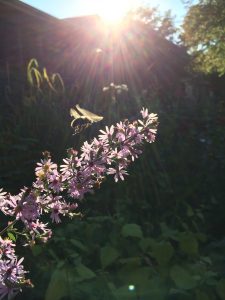
Fall: There are so many different native asters and goldenrods, which are the backbone for a pollinator garden in the fall. Aromatic Aster (blooms though October), New England Aster, Calico Aster, Short’s Aster, Stiff Goldenrod, Showy Goldenrod, Canadian Goldenrod,(aggressive and hated by ecological restorationists, but is very attractive to pollinators of all kinds), Zig-Zag Goldenrod, Elm-leaved Goldenrod, Blue-stemmed Goldenrod, Grey Goldenrod. Blue Mist flower is aggressive too but is gorgeous in the fall and pollinators love it. White Snakeroot is also an aggressive self-seeder but is appreciated by pollinators in the fall.
5. What other resources can I give them?
Nesting habitat! 70 % of our native bees are ground nesters; they are solitary but might form aggregations together (sort of like an apartment building for us). They need bare ground. Avoiding heavy mulching or compacting in nesting sites is important. No pesticides, fungicides, fertilizers, etc.Bumblebees often like the area underneath native grasses.
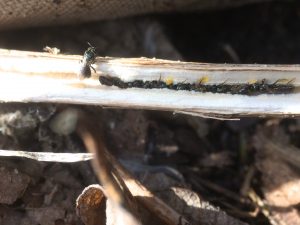
The other 30% will use cavities. Depending on the species, they will use stems, either already hollow or pithy ones they will excavate. Some will use logs, while others might even use bricks. Leaving some “stem stubble” as Heather Holm terms it in the spring will provide many species with a place to nest. Remove last year’s stems later in the season. Perhaps place in a loose brush pile just in case there are any more bee larvae or pupae in there.
You can provide nesting boxes if you like. There’s not a lot of research on how effective they are. There was one study that showed that Mason bee boxes made it pretty easy for predators and bee parasites to access the bee larvae, sort of like a buffet. Let us know if you use one and how it goes.
For pollinators like butterflies and moths, they will need host plants and a light touch on garden clean up as well since many of them overwinter in the garden/yard. Flies and beetles also benefit from leaf litter and garden debris, such as stems, since part of their life cycle occurs in the soil food web which has as its foundation decomposing plant material.
Water source: Some people will put out shallow pans with stones or sand to give the pollinators a place to land and safely drink water. Cup plant is good for this as well–they will use the water that collects in the pocket created by where the leaves surround the stem.
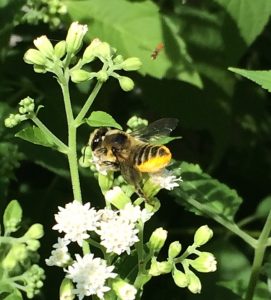
Leaf material: Some bees use parts of leaves, either cutting pieces or “carding” material from plants. Roses are a common material for leaf cutters. Carders and leaf cutters love a plant like Prairie Sage. They roll up the fuzzy part of the leaf and use it to line their nest.
Protect plants if possible when there is Mosquito spraying.
Remove invasive species from your yard and plant native plants.
This post is just a tiny snippet of information. Listed below are books, web articles, and sites for recommended reading.
Books:
Attracting Native Pollinators, Xerces Society
Farming with Beneficial Insects, Xerces Society
Pollinators of Native Plants, Heather Holm
Bees: An Identification and Native Plant Forage Guide, Heather Holm
Websites/Articles:
Nature: Honeybees disrupt the structure and functionality of plant-pollinator networks
Yale 360
Backyard Battle: Helping Native Bees Thrive in a Honeybee World
“Native bees are at risk across the United States. “Buzz Kill” — winner of the 2020 Yale Environment 360 Video Contest — depicts the beauty and key ecological role played by these bees and shows how industrialized agriculture and its use of honeybee colonies threatens endemic bee species.”
Heather Holm: Save Our Bees This article by well-known native bees expert and advocate pulls together some of the major science emerging around the issue of how honeybees negatively impact native bees.
Science Daily: Honeybees infect wild bumblebees through shared flowers
PLOS ONE: RNA virus spillover from managed honeybees (Apis mellifera) to wild bumblebees. Study referenced in the above Science Daily article.
Ben Vogt: Honey Bees Compete with Native Bees Vogt’s article also provides a bit of an annotated bibliography to recent research.
Recap of Rusty-patched Bumblebee Program by Fayette Aurelia Nichols Includes important plants to have in our gardens for them & for other bumblebees.
Heather Holm’s Bumblebee Banquet list and chart
Newsweek: Wild Bees Are Dying
International Journal for Parasitology: Parasites and Wildlife: Do managed bees drive parasite spread and emergence in wild bees?
Science: How the Bees You Know are Killing the Bees You Dont
Futurism: Even if We Save the Honeybee, Other Wild Pollinator Species Will Still Be in Trouble
Scientific American: Bees Gone Wild
Science Journal: Conserving honeybees does not help wildlife
Conservation Biology: Questioning public perception, conservation policy, and recovery actions for honeybees in North America
NPR’s Science Friday: Beyond Honeybees
Heather Holm’s website: http://www.restoringthelandscape.com/ or /http://www.pollinatorsnativeplants.com/
Bee Basics: Publication by USDA and the Pollinator Partnership
Return of the Natives: How Wild Bees Will Save Our Agricultural System
You’re Worrying about the Wrong Bees
Gauging the Effect of Honey Bee Pollen Collection on Native Bee Communities Stunning statistic from this study: A honeybee colony gathers the equivalent of about 100,000 solitary bee larval-food pollen balls per season.
BeeSpotter (UIC’s page)
Chicago Botanic Garden: ABC’s of Bees
Effects of Invasive Species on Pollinators
Urban Refuge: How Cities Can Help Rebuild Declining Bee Populations
NWF’s A Helping Hand for Early Bees
Pollinator Diversity: Distribution, Ecological Function, and Conservation
Kelley Beekeeping: How much land to feed one bee colony?
All photos and text: Stephanie Walquist
Recorded Presentation:
University of Missouri researcher Damon Hall’s presentation dives into what’s being done across the US to create pollinator-friendly policy from the national to the municipal level. He also discusses good examples, both in the US and elsewhere, and describes how to influence policy where you live.
